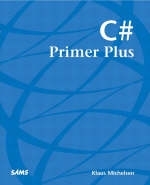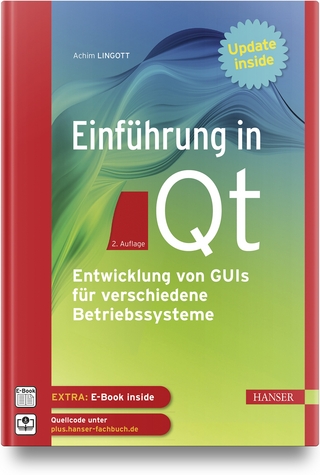
C# Primer Plus
Sams Publishing (Verlag)
978-0-672-32152-8 (ISBN)
- Titel ist leider vergriffen;
keine Neuauflage - Artikel merken
C# Primer Plus is a tutorial based introduction to the C# language and important parts of the .Net Framework. Throughout the book the reader will be exposed to proven principles enabling him to write clean, high-quality programs. Object-oriented programming and principles are a cornerstone of the book. C# Primer Plus aims to make OOP clear and applicable without being too technical through a gentle introduction and bountiful examples. The book uniquely utilizes the concreteness of the C# language to explain the fuzzy concepts of OOP. It will allow the reader to experiment with OOP and confirm her newly acquired knowledge. OOP will on the other hand help explain why C# is designed the way it is. To avoid superfluous distractions only the most relevant parts of the .Net library classes will be discussed.
Klaus Michelsen has a Masters degree in Economics from Aarhus University in Denmark. His studies included artificial intelligence and courses in advanced computer science at Sydney University in Australia. Since his first programming assignment for a shoe shop when he was 18, he has, during his 15 years of programming experience, been exposed to many different technologies and programming languages, including Java, Visual J++, C++, MS Access, VB, Eiffel, and Pascal. Klaus has been working with C# and .NET since their introduction in the year 2000.
Introduction.
1. Computers and Computer Programming: Basic Concepts.
C# Is an Object-Oriented Programming Language. Hardware. Software. Summary. Review Questions.
2. Your First C# Program.
Software Development. The Software Development Process. Algorithms and Pseudocode. The Three Different Types of Errors. Object-Oriented Programming: A First Encounter. Software Reuse. The Assembly, the Basic Unit of Code Reuse in .NET. The .NET Framework Class Library. C#: History and Design Goals. C#'s Background. C#'s Design Goals. What Kind of Programs Can I Write with C#? The Mechanics of Creating a C# Program. Before Getting Started. Choosing a Text Editor. The Seven Steps to Writing a Simple C# Program. A Brief Source Code Analysis. Note on Syntax Errors and Compilers. Summary. Review Questions. Programming Exercises.
3. A Guided Tour through C#: Part I.
Introduction. Abstraction and Encapsulation. An Interactive Hello World! Program. Summary. Review Questions. Programming Exercises.
4. A Guided Tour through C#: Part II.
Introduction. Essential Elements of SimpleCalculator.cs. Simplifying Your Code with Methods. Methods as Building Blocks: Encapsulating Your Helper Methods with the private keyword. Summary. Review Questions. Programming Exercises.
5. Your First Object-Oriented C# Program.
Introduction. Lexical Structure. Some Thoughts on Elevator Simulations. Concepts, Goals and Solutions in an Elevator Simulation Program: Collecting Valuable Statistics for Evaluating an Elevator System. Object-Oriented Programming: A Practical Example. Summary. Review Questions. Programming Exercises.
6. Types Part I: The Simple Types.
Introduction. Types in C#: An Overview. Simple Types. The Blipos Clock. Summary. Review Questions. Programming Exercises.
7. Types Part II: Operators, Enumerators, and Strings.
Introduction. Arithmetic Operators and Numerical Expressions. Associativity. Parentheses and Precedence. The Modulus Operator (%). Unary Operators. Determining the Type of an Expression. Combining Different Types in One Expression. Accessing the Metadata of a Component: A Brief Introduction. Enumerated Constants. Enumerator Operators. Conversions. The Methods of System.Enum. Characters and Text. The char Type. The string type. Summary. Review Questions. Programming Exercises.
8. Flow of Control Part I: Branching Statements and Related Concepts.
Introduction to Flow of Control. Branching with the if Statement. Comparison Operators and Boolean Expressions. Nested if Statements. Multibranch if-else Statements. Logical Operators. The Scope of Variables. The goto Statement. The switch Statement. The Conditional Operator. Summary. Review Questions. Programming Exercises.
9. Flow of Control Part II: Iteration Statements.
Traversing, Analyzing, and Generating Sequences of Data. The while Loop Statement. The do-while Loop Statement. The for Loop Statement. The Jump Statements break and continue. Structured Programming and Structured Constructs. Combination Assignment Operators. Nested Iteration Statements. Programming Exercises. Summary. Review Questions. Programming Exercises.
10. Arrays Part I: Array Essentials.
Declaring and Defining an Array. Accessing Individual Array Elements. Array Indexes Out of Range. Adjusting for the Zero-Based Array Index. Initializing Arrays. Traversing an Entire Array with the foreach Statement. System.Array Is a Reference Type. Arrays and Equality. Arrays and Methods. A Method to Perform Array Value Equality Comparisons. Command Line Arguments. Using Arrays As Return Values from Methods. Array Elements Referencing Objects. Arrays As Instance Variables in Classes. Summary. Review Questions. Programming Exercises.
11. Arrays Part II: Multidimensional Arrays— Searching and Sorting Arrays.
Multidimensional Arrays. Arrays of More Than Two Dimensions. The Built-In Methods of System.Array. Special Array Techniques. Searching. Summary. Review Questions. Programming Exercises.
12. Class Anatomy Part I: static Class Members and Method Adventures.
The Anatomy of a Class: Overview. Data Members. Function Members. Summary. Review Questions. Programming Exercises.
13. Class Anatomy Part II: Object Creation and Garbage Collection.
Instance Constructors. static Constructors. The readonly Member. Garbage Collection: Automatic Dynamic Memory Management. Summary. Review Questions. Programming Exercises.
14. Class Anatomy Part III: Writing Intuitive Code.
Properties. Indexers: Using Objects Like Arrays. Operator Overloading. User-Defined Implicit and Explicit Conversions. Nested Types. Summary. Review Questions. Programming Exercises.
15. Namespaces, Compilation Units, and Assemblies.
Defining Your Own Namespaces. The Global Nameless Namespace. Namespaces and Compilation Units. Nested Namespaces. Namespace Syntax. More About the using Directive. Compile Units, Namespaces, and Assemblies. Exploring Assemblies with the Ildasm Utility. Summary. Review Questions. Programming Exercises.
16. Inheritance Part I: Basic Concepts.
The Need for Inheritance. Inheritance Fundamentals. Access Modifiers and Inheritance. Derived Class Constructors. Indexers Are Also Inherited and Can Be Overridden. Calling an Overridden Function in the Base Class. Reusing the .NET Framework Class Library with Inheritance. Multiple Levels of Derived Classes. Method Overriding and Overloading Are Different Mechanisms. Summary. Review Questions. Programming Exercises.
17. Inheritance Part II: abstract Functions, Polymorphism, and Interfaces.
abstract Methods, Properties, Indexers, and Classes. Polymorphism. Losing and Regaining Type Information. System.Object: The Ultimate Base Class. Summary. Review Questions. Programming Exercises.
18. Structs.
Defining a Struct. Boxing and Unboxing. Creating Structs with and without new. Value Types and Reference Types. Summary. Review Questions. Programming Exercises.
19. Exception Handling.
Exception Handling: A Brief Overview. Life without try-catch-finally. The try and catch blocks. Catching the Exception Object Farther up the Function Call Chain. Multiple catch Blocks. The finally Block. Nested try Block. throw: Explicitly Throwing Exceptions. Writing Custom Exceptions. Summary. Review Questions. Programming Exercises.
20. Delegates and Events.
Delegates. Events. Summary. Review Questions. Programming Exercises.
21. Preprocessing, XML Documentation, and Attributes.
Preprocessor Directives. XML Documentation. Attributes. Summary. Review Questions. Programming Exercises.
22. File I/O Basics.
The Need for Files. Stream Basics and File I/O. File I/O Classes: An Overview. The FileInfo Class. Text File Input and Output with StreamReader and StreamWriter. Binary Input and Output with the FileStream Class. Summary. Review Questions. Programming Exercises.
23. Recursion Fundamentals.
Pending Method Instances of Different Methods. Pending Method Instances of the Same Method. Putting Recursion to Work: Calculating n Factorial. Recursion and Iteration. Binary Search Using Recursion. Summary. Review Questions. Programming Exercises.
Appendix A: Answers to Quizzes and Exercises.
Chapter 1. Chapter 2. Chapter 3. Chapter 4. Chapter 5. Chapter 6. Chapter 7. Chapter 8. Chapter 9. Chapter 10. Chapter 11. Chapter 12. Chapter 13. Chapter 14. Chapter 15. Chapter 16. Chapter 17. Chapter 18. Chapter 19. Chapter 20. Chapter 21. Chapter 22. Chapter 23.
Index
| Erscheint lt. Verlag | 14.12.2001 |
|---|---|
| Verlagsort | Indianapolis |
| Sprache | englisch |
| Maße | 100 x 100 mm |
| Gewicht | 100 g |
| Themenwelt | Mathematik / Informatik ► Informatik ► Programmiersprachen / -werkzeuge |
| Informatik ► Software Entwicklung ► Objektorientierung | |
| ISBN-10 | 0-672-32152-1 / 0672321521 |
| ISBN-13 | 978-0-672-32152-8 / 9780672321528 |
| Zustand | Neuware |
| Haben Sie eine Frage zum Produkt? |
aus dem Bereich


